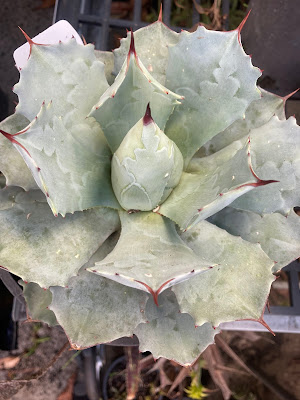FLOREZ NURSERY CLOSED For more information on plants featured here phone Ian on 0412 123 240 or email nurseryflorez@gmail.com Mailing Address: Post Office Box 143 Berkeley NSW 2506 Australia
Sunday, November 14, 2021
Agave isthmensis
Thursday, November 4, 2021
Reseda odorata 'Machet Ruben' (Mignonette)
Reseda odorata 'Machet Ruben'
(Resedaceae)
I have not grown this spring flowering annual for a number of years and came across it in a seed catalogue while ordering summer vegetables. August here is the month when you can start seeds indoors in a bright location. Germination was quick and they were ready for potting on in no time. While most gardening books say it can be difficult to transplant into garden beds, I had success with placing three or four seedlings close together in 175 mm pots which was to be their flowering 'home'.
I placed the pots along a low wall in full sun to help kickstart them during the normal cold early spring days. Growth was slow at first but they responded to some liquid fertilizer and they soon became bushy plants to about 30cm with flower spikes appearing in late September at which time I moved the pots to bench height to better enjoy the sweet perfume released from the flower spikes in late afternoon. You don't have to stick your nose up close either as the fragrance is in the air from a distance away. It is described as ambrosial so no wonder the French in the southern perfume industry region called this plant Mignonette or 'little darling'.
Bill Simpson in his book Growing Annuals (Kangaroo Press 1988) described the flower as having orange red bell clapper stamens protruding like grapes from insignificant white-yellow 6mm wide flowers accompanied by smooth spoon shaped plain green leaves. The leaves wilt quite quickly on hot days or when the plants are lacking water so the ideal location is in a semi shaded garden position with moisture retentive soil.
It is a North African plant in origin and it must have caught the eye of 19th Century naturalist Charles Darwin who used it to study self-fertilized plants published as The effects of cross and self fertilization in the vegetable kingdom.
Mignonette is not showy but as perfumed flowers go it is up there with the best.


